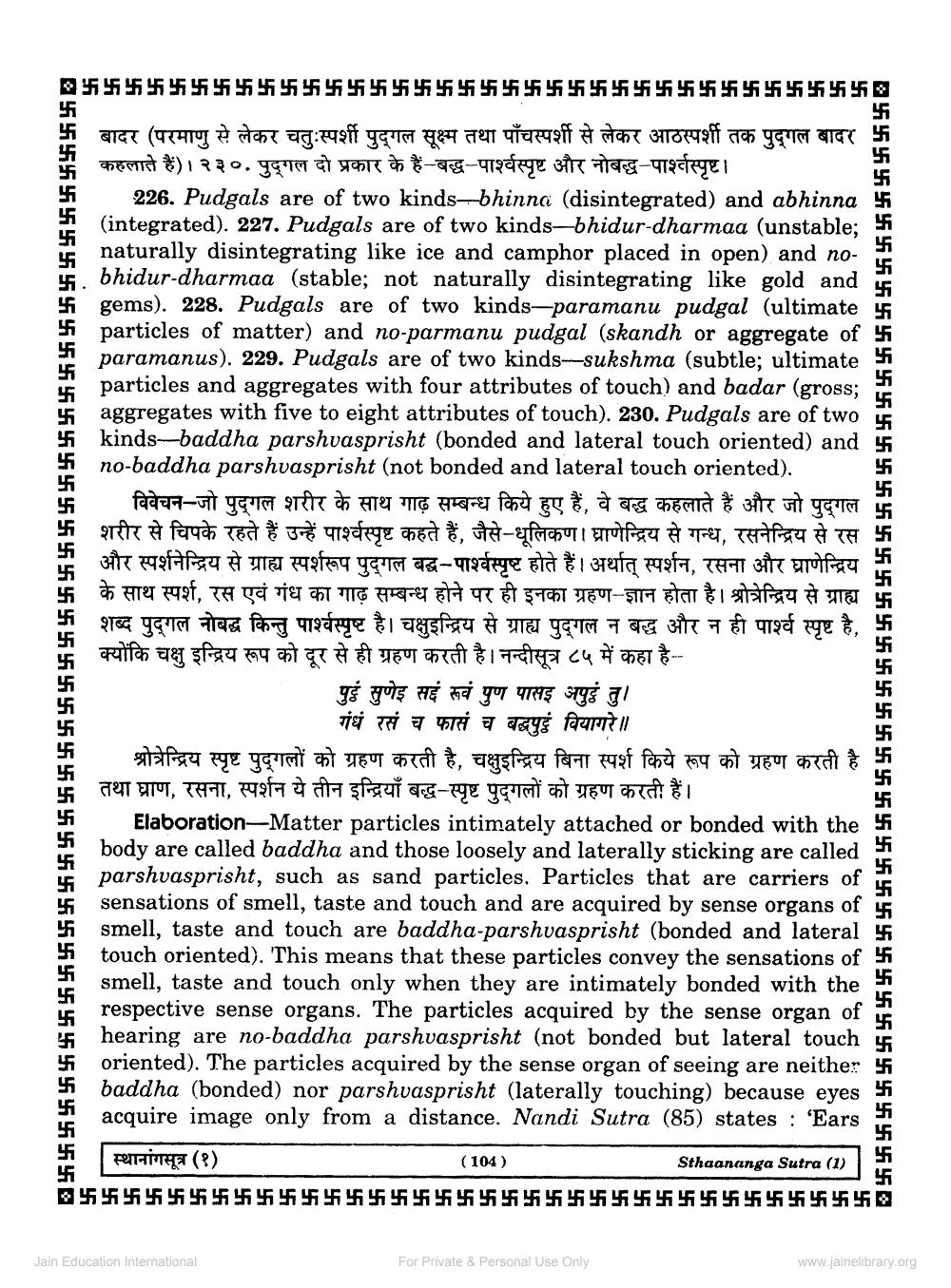________________
a55 $55 55 $55 5 $$ $$$$$$$$$$$$$$$$ 55FFFFFm
))
卐)
+ बादर (परमाणु से लेकर चतुःस्पर्शी पुद्गल सूक्ष्म तथा पाँचस्पर्शी से लेकर आठस्पर्शी तक पुद्गल बादर 卐 कहलाते हैं)। २३०. पुद्गल दो प्रकार के हैं-बद्ध-पार्श्वस्पृष्ट और नोबद्ध-पार्श्वस्पृष्ट ।
226. Pudgals are of two kinds-bhinna (disintegrated) and abhinna (integrated). 227. Pudgals are of two kinds-bhidur-dharmaa (unstable; naturally disintegrating like ice and camphor placed in open) and no
bhidur-dharmaa (stable; not naturally disintegrating likes 卐 gems). 228. Pudgals are of two kinds-paramanu pudgal (ultimate :
particles of matter) and no-parmanu pudgal (skandh or aggregate of 4 paramanus). 229. Pudgals are of two kinds--sukshma (subtle; ultimate particles and aggregates with four attributes of touch) and badar (gross aggregates with five to eight attributes of touch). 230. Pudgals are of two kindsbaddha parshvasprisht (bonded and lateral touch oriented) and
no-baddha parshvasprisht (not bonded and lateral touch oriented). ॐ विवेचन-जो पुद्गल शरीर के साथ गाढ़ सम्बन्ध किये हुए हैं, वे बद्ध कहलाते हैं और जो पुद्गल + शरीर से चिपके रहते हैं उन्हें पार्श्वस्पृष्ट कहते हैं, जैसे-धूलिकण। घ्राणेन्द्रिय से गन्ध, रसनेन्द्रिय से रस म
और स्पर्शनेन्द्रिय से ग्राह्य स्पर्शरूप पुद्गल बद्ध-पार्श्वस्पृष्ट होते हैं। अर्थात् स्पर्शन, रसना और घ्राणेन्द्रिय ॐ के साथ स्पर्श, रस एवं गंध का गाढ़ सम्बन्ध होने पर ही इनका ग्रहण-ज्ञान होता है। श्रोत्रेन्द्रिय से ग्राह्य 5 शब्द पुद्गल नोबद्ध किन्तु पार्श्वस्पृष्ट है। चक्षुइन्द्रिय से ग्राह्य पुद्गल न बद्ध और न ही पार्श्व स्पृष्ट है, म क्योंकि चक्षु इन्द्रिय रूप को दूर से ही ग्रहण करती है। नन्दीसूत्र ८५ में कहा है--
पुढे सुणेइ सई रूवं पुण पासइ अपुढे तु।
गंधं रसं च फासं च बद्धपष्टुं वियागरे॥ ___श्रोत्रेन्द्रिय स्पृष्ट पुद्गलों को ग्रहण करती है, चक्षुइन्द्रिय बिना स्पर्श किये रूप को ग्रहण करती है तथा घ्राण, रसना, स्पर्शन ये तीन इन्द्रियाँ बद्ध-स्पृष्ट पुद्गलों को ग्रहण करती हैं।
Elaboration-Matter particles intimately attached or bonded with the body are called baddha and those loosely and laterally sticking are called parshvasprisht, such as sand particles. Particles that are carriers of sensations of smell, taste and touch and are acquired by sense organs of 5 smell, taste and touch are baddha-parshvasprisht (bonded and lateral 41 touch oriented). This means that these particles convey the sensations of smell, taste and touch only when they are intimately bonded with the respective sense organs. The particles acquired by the sense organ of hearing are no-baddha parshvasprisht (not bonded but lateral touch oriented). The particles acquired by the sense organ of seeing are neithe.. baddha (bonded) nor parshvasprisht (laterally touching) because eyes acquire image only from a distance. Nandi Sutra (85) states : 'Ears
四听听听听听听听听听听听听听听听听听听听听听听听听听听听听听听听听听听听听听听听听听听听听听听听听听。
| स्थानांगसूत्र (१)
(104)
Sthaananga Sutra (1)
Jain Education International
For Private & Personal Use Only
www.jainelibrary.org




